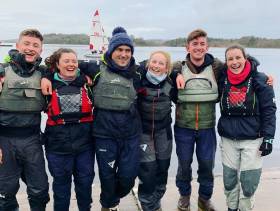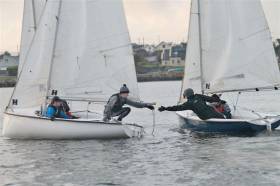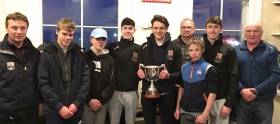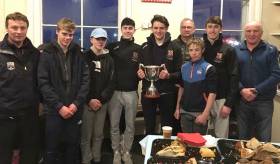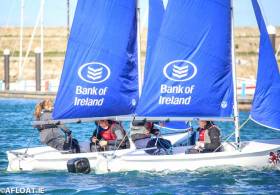Displaying items by tag: Team Racing
Hot on the heels of the Irish Youth National Championships at Royal Cork Yacht Club, the Irish Schools Team Racing Championships will be held this coming weekend also in Cork in a packed month of sailing for youth sailors.
Organiser David Harte from the Fastnet Education Centre has issued a reminder to the 12 competing teams (plus two in reserve) of the upcoming championships to be sailed in TR3.6 dinghies at Schull, as Afloat previously reported here.
Gonzaga College in Dublin travel to Roaringwater Bay as Leinster Champions having lifted the trophy at the Royal St. George Yacht Club last month.
A flight sheet will be issued this Thursday.
The 2019 Schools Team Racing championships at Schull in West Cork looks set to be the biggest yet when it sets sails from the Fastnet Marine Centre in the town on May 4.
There will be 13 teams from Munster, seven from Connacht and eight from Leinster competing.
Gonzaga College in Dublin travel to Roaringwater Bay as Leinster Champions having lifted the trophy at the Royal St. George Yacht Club last month.
Teams will compete in the locally built TR3.6 dinghies.
Download entry forms and a Notice of Race below.
Lucy McCutcheon, Commodore and Team Sailing Captain of University College Dublin SC, is the Afloat.ie “Sailor of the Month (Team Racing) for March after her squad’s victory in very close racing in the Irish Universities Team Championship staged at Lough Key off the Upper Shannon March 9th & 10th.
The organisers for 2019 at this unusual but very attractive venue were Dublin University SC. But in a nail-biting final with UCD, they were bested by their longtime rivals, and while it was very much a team success, we follow established precedent in awarding the SoM accolade to the UCD Captain.
More on this story here
Hosted by the Royal St George Yacht Club, eight teams competed in Fireflies for the title last weekend in mostly light airs and acquitted themselves perfectly providing entertaining team racing in Dun Laoghaire harbour.
A light breeze faded by midday and after an hour filled in from the east providing a good team racing in the afternoon to complete the first round.
After the round robin, only one point separated Gonzaga 1 from the other semi-final chasing teams who comprised Loreto Stephens Green, St Andrews College and Blackrock College. Loreto SG took Gonzaga to three races before narrowly losing the deciding race and St Andrews dispatched 'Rock' without a loss. Andrews went down fighting to Gonzaga who had recovered their form from the close call with Loreto SG.
"The top four teams qualify for the all Ireland Schools to be run by FOMEC in Schull in April"
The top four teams qualify for the all Ireland Schools to be run by FOMEC in Schull in April.
The excellent event was well run by Eunice Kennedy who led the team in the George and the parents who enthusiastically rallied the teams and supported the event.
Thanks are due to the George and Dublin University Sailing Club who loaned the Fireflies and KSail.co.uk who provided the draw.
Gonzaga
Jack Fahy & Andrew Conan
Henry Higgins & Finn Cleary
Tom Higgins & Jacques Murphy
St Andrews College
Finn Walker & Oisin Hughes
Eve McMahon & Kei Walker
Kitty Flanagan & Amelia Johnson
Blackrock College
Morgan Lyttle & Colm Roche
Hugh O’Connor & Conor Gorman
Charlie Cullen & Colm Hogan
Loreto St Stephens Green
Ella Hemryk &Tara Berry
Nell Staunton & Joanna Berry
Natasha Hemryk & Ciara Paul
Loreto Foxrock, Alexandra College, Gonzaga2 and St Conleth’s College comprised the remaining teams.
St Enda’s College Win Connacht Schools Team Racing Championship
For the second year in a row, Comhghairdeas Coláiste Éidne (St Enda’s College) Galway won the Connacht Schools Team Racing Championship on Sunday 3 March in Carraroe, hosted by Cumann Bádóireachta agus Seoltóireachta.
Six teams from in and around Connacht were able to make the event despite the postponement of racing to Sunday due to westerly gale force winds hammering the bay on Saturday.
The schools included St Enda’s, Athlone Community Marist College Athlone, Calasanctius Oranmore and host school Scoil Cuimsitheach Chiaráin Carraroe.
Every team got to race each other in a full fleet of Fireflies, and St Enda’s were delighted to come away with the win up against strong challengers in Athlone Community College and Marist College Athlone, who placed second and third respectively.
The top three teams now go through the Schools National Team Racing Finals hosted by Schull Community School on the weekend of 4-5 May.
Gonzaga College's Jack Fahy is January’s Sailor of the Month
With his captaining of the successful Gonzaga College team in the inaugural Shanahan Cup raced at the Irish National Sailing School on January 16th, noted junior sailor Jack Fahy is the Afloat.ie “Sailor of the Month” for January 2019.
Competing against eight other top school teams, the Gonzaga squad put in a convincing performance under the race direction of team racing guru Vincent Delany.
While the contribution of fellow team members Andrew Conan, Henry Higgins, Finn Cleary, Tom Higgins and Con Murphy was very significant, it was Jack Fahy who led the way for a trophy generously donated by our 2015 Sailor of the Year Liam Shanahan.
Nine Teams from Six Dublin Schools Compete in the Inaugural Shanahan Team Racing Cup
Nine teams from six Dublin schools (Holy Child, Blackrock College, Loreto on the Green, Gonzaga College, St Gerard's and Loreto Foxrock) competed in the inaugural Gonzaga College/Irish National Sailing & Powerboat School school’s team racing event for the Shanahan Cup on 16 January 2019. Sailing in the Irish National Sailing & Powerboat School’s fleet of Topper Topaz Vibe dinghies, the teams faced testing conditions in a cold northwesterly wind which ranged from two to 20–knots.
Vincent Delany kicked off the day with a hugely informative briefing to all sailors before heading to sea as, for some. this was their first experience of team racing. After a short delay, the fleet assembled in the training area of Dun Laoghaire Harbour where the course was pre-laid and ready for action.
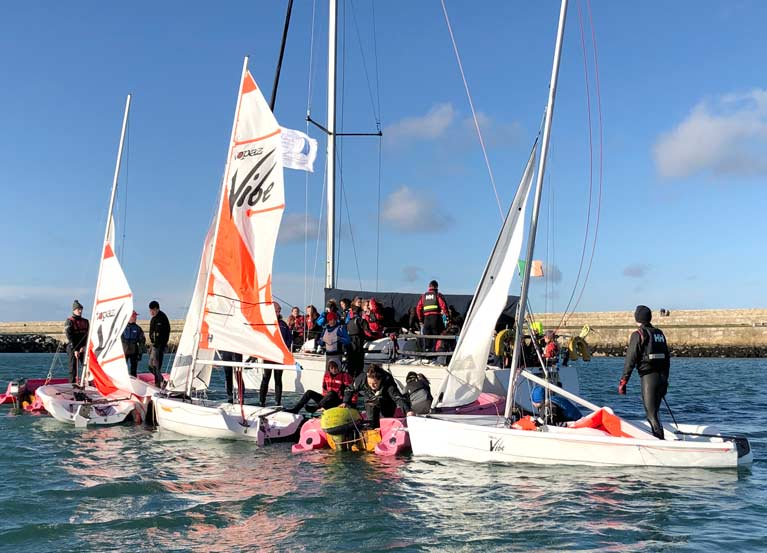 The Cup was sailed sailed in the Irish National Sailing & Powerboat School’s fleet of Topper Topaz Vibe dinghies
The Cup was sailed sailed in the Irish National Sailing & Powerboat School’s fleet of Topper Topaz Vibe dinghies
Notwithstanding that many of the young sailors had suffered dunkings during the numerous capsizes in the early races the youngsters seemed oblivious to the cold and a lively party continued all day on Lula Belle, one of the INSAPS’s fleet of cruising yachts which was tied alongside the pontoon in the training area of Dun Laoghaire Harbour. Hot chocolate and warm treats were on supply day round which gave sailors the chance to warm up ahead of their next race. The large pontoon ensured swift turnarounds of crews between dinghies before the next race.
Pool I was very closely fought and resulted in a three-way sail off between Blackrock College, Gonzaga B and Loreto on the Green, with Blackrock emerging as the victors.
Pool II was dominated by a powerful Gonzaga A team who won all their races and then faced Blackrock in the final. In a hotly contested start, Blackrock suffered an OCS of one of their boats which left them with too much catching up to do and Gonzaga emerged winners.
Speaking after the event Kenneth Rumball of the Irish National Sailing & Powerboat School emphasized the huge opportunities that existed in schools sailing. “Team racing represents a fantastic opportunity for young people to develop key sailing skills and to do it in a format that builds friendships and healthy rivalry between schools”
At the prizegiving, Fiachra Etchingham of Gonzaga College commended the high standard of sailing but emphasized that equally important was the younger and less experienced sailors who went out in difficult conditions and “gave it a go”.
Presenting the trophy Liam Shanahan encouraged the competitors not to focus too much on the results but to look at sailing as lifelong sport which afforded them opportunities to make friends and have fun.
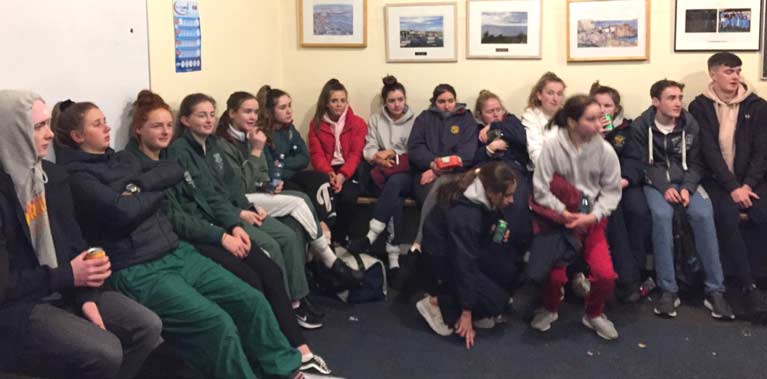 Nine teams from six Dublin schools (Holy Child, Blackrock College, Loreto on the Green, Gonzaga College, St Gerard's and Loreto Foxrock) competed in the inaugural Gonzaga College/Irish National Sailing & Powerboat School school’s team racing event
Nine teams from six Dublin schools (Holy Child, Blackrock College, Loreto on the Green, Gonzaga College, St Gerard's and Loreto Foxrock) competed in the inaugural Gonzaga College/Irish National Sailing & Powerboat School school’s team racing event
Dublin Secondary Schools are renowned for various sports and in particular for team sports. However, when one looks at the full range of sports played in Dublin schools, there are very few sports where girls compete against boys on equal terms. Sailing is one sport where they sail on equal terms.
50+ youngsters left the Irish National Sailing & Powerboat School with smiles on their faces looking forward to next year!
"not to focus too much on the results but to look at sailing as a lifelong sport which afforded them opportunities to make friends and have fun"
The event could not have taken place with mention of some key contributors. Fiachra Etchingham was the mastermind and instigator to which the event would not have taken place without his vision. Vincent Delany brought his considerable knowledge of team racing to ensure everything was set for the event to run smoothly as well as leading the team of highly experienced umpires. The Irish National Sailing and Powerboat School provided all the equipment facilities and logistical support. Liam Shanahan for his love of the sport sponsored the inaugural event.
The winning Gonzaga team was:
Jack Fahy, Andrew Conan
Henry Higgins, Finn Cleary
Tom Higgins, Con Murphy
Special thanks should go to the volunteers on the day comprising of;
Mark Delany, Tom Fitzpatrick, Trisha Kelly, Patricia Lawler, Michael Tyrell, Alistair Rumball, James Linton, Jill Fleming and a team of Gonzaga mothers who gave up the day out of their busy schedules to make the event such a success!
Irish Sailing Seeks Funding to Support Team Racing Strategy
Irish Sailing is putting together a funding application to support Irish Sailing’s Team Racing strategy and is seeking quotes for a contractor to develop the programme starting late Spring of 2019 with a tight timeline for the funding application.
Irish Sailing is seeking quotes from self-employed contractors, for a one-year, full time, initial contract as Irish Sailing’s Team Racing Development Officer.
The primary role of the TRDO is to develop Team Racing across Irish Sailing organisations for the purpose of increasing membership activity, retaining keen sailors, and increasing participation. The successful candidate may be based anywhere in Ireland and will work in conjunction with the existing development officers, policy groups and Irish Team Racing Association to support Irish Sailing affiliated Clubs, Classes and accredited Training Centres to grow and develop their team racing activities.
With a fleet of Team Racing dinghies, the successful contractor will develop and deliver programmes and initiatives in line with Irish Sailing strategies, to expand team racing across Ireland in Irish Sailing affiliated Clubs and accredited Training centres to include
- coaching (race management and team racing sailors both ashore & on the water)
- development of regional links between Clubs, Training Centres, Classes and Colleges
- maintenance of robust Irish Sailing TR dinghy fleet
- event support
While upskilling may be available, ideally the contractor will be:
- self-motivated, proactive and professional, with drive and vision
- a passionate and active sailor and team racer
- over 20 years of age with a full driver’s licence
- an excellent communicator
- a qualified instructor/coach
Initially, the funding being applied for is for a one year contract for the 2019 season, which may be extended if the programme is successful.
In the event of a successful funding application, a formal selection process will be initiated during the middle of March, with a view to starting April 2019.
The timeline for funding application is tight. Please send a letter of application and CV, along with a quote for a daily rate being sought for the role to Harry Hermon, Chief Executive by email to; [email protected] before close of business on Friday 18th January.
UCD Sailing Club Hosting Charity Team Racing Event in Aid of 'Movember'
UCD Sailing Club is hosting a charity run team racing event in aid of the Movember foundation on the 1st of December out of the Royal Irish Yacht Club in Dun Laoghaire Harbour.
Club members have been working hard growing moustaches to shave off at the event.
Movember is an annual event that raises awareness of men's health issues, such as prostate cancer, testicular cancer, and men's suicide.
According to a spokeswoman, UCD Sailing Club would appreciate any donations to go to their IUSA Movember fund here.
Irish Team Racing Association Lends Support to INSS & Gonzaga College January Initiative
The Irish Team Racing Association has given its support to the new Schools team racing initiative launched by Gonzaga College and the Irish National Sailing School.
The INSS event will consist of one day's team racing using the INSC’s fleet of double-handed dinghies. It is open to all Leinster schools and schools can field more than one team. In the long term, it is hoped to build the event into a league and possibly introduce a fleet for younger sailors using RS Feva double-handed dinghies. More on the event here
ITRA's Ailbe Millerick says the association will help with the race organisation, training and umpiring for the event on the 16th January 2019.
ITRA hopes the inaugural match will be a good pre-event warm-up for the Leinster Schools Championships in March.





























